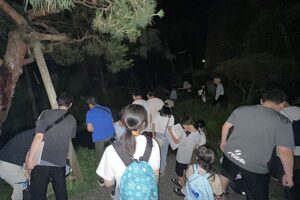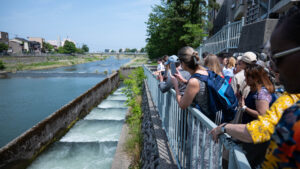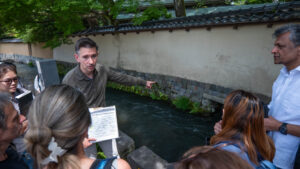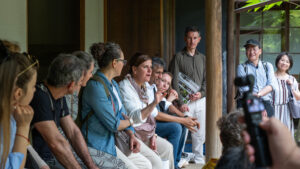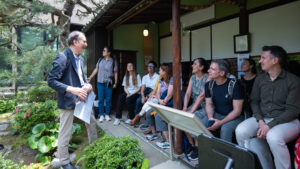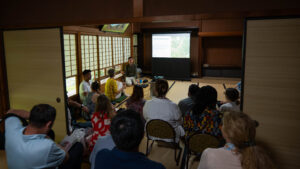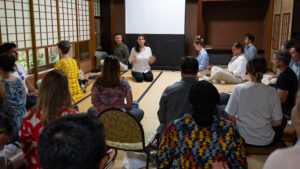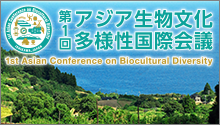The book introduces unique roles and teachings of Japanese Gardens in Kanazawa City in a relation with human society and it is breaking new ground for Kanazawa’s sustainable future.
Kanazawa:アーカイブ
OUIK Biocultural Diversity Series #5 Restoring Kinship with Nature through Japanese Gardens -The Challenge to Achieve a Sustainable Commons in Kanazawa
Youth Capacity Building Workshop towards UN’s Sustainable Development Goals
From January 1, 2016 until 2030, United Nations adopted Sustainable Development Goals (SGDs), with 17 goals and 169 targets, to end poverty, protect the planet, and ensure prosperity for all. These goals are applied to all countries and regions, and for the next 15 years they will be the critical tools in the dialogs to solve environmental, economic and social issues. Youth capacity development towards those issues will be essential to ensure the successful achievements of those goals. This Workshop is jointly created by Kanazawa University and United Nations University, and it aims to create the platform for the younger generations to come together and deepen the discussions on SDGs and share the regional issues.
OUIK Biocultural Diversity Series #4 [Learning About the Satoyama and Satoumi of Hokuriku Region from Maps]
Event Report – International Symposium on Urban Ecosystem Regeneration “Nature, Culture, and Community: Rethinking Urban Connections from Kanazawa”
On May 22, 2025, the International Symposium “Nature, Culture, and Community: Rethinking Urban Connections from Kanazawa” took place at the Kanazawa Bunka Hall. As cities around the world continue to grow and evolve, the interconnections between nature, culture, and community are increasingly central to shaping sustainable urban futures. This symposium brought together local and international experts, as well as city representatives, to explore innovative approaches to urban ecosystem regeneration while respecting and celebrating cultural heritage.
The event began with opening remarks from Takashi Murayama (Mayor of Kanazawa City).
Keynote speeches followed, featuring:
- Yulia Rubleva (Associate Programme Management Officer, Urban Nature, UNEP)
- Ingrid Coetzee (Director, Biodiversity, Nature & Health, ICLEI Africa
- Wataru Suzuki (Director, Biodiversity Strategy Office, MOEJ)
Rubleva presented on “Urban Nature for People and Planet: Restoring Ecosystems, Rebuilding Community”, and emphasized the growing recognition of nature’s critical role in building healthy, resilient cities. She stressed the importance of reconnecting cities with nature – not just for aesthetic value, but for their capacity to sustain life, foster culture and strengthen communities in this changing world.
Next, Coetzee presented on “Nature contributing to wellbeing, resilience, and connectivity in cities”, and showcased examples of urban initiatives that reflect strong links between ecological and human wellbeing, understanding the importance of partnerships and active community engagement.
Suzuki discussed “Cities for a society harmony with nature,” highlighting that Kanazawa has historically coexisted with nature. He emphasized that to restore biodiversity, it is necessary to simultaneously promote green conservation and restoration, climate change countermeasures, sustainable production, and consumption reduction. He also offered valuable insights connecting global, national, and local levels – from the implementation of the Post-2020 Global Biodiversity Framework (GBF), to Japan’s new national biodiversity strategy, and concrete applications of Nature-based Solutions at the local level.
The second half of the symposium featured a panel discussion moderated by Togo Uchida (Executive Director, ICLEI Japan), with contributions from:
- Dzheylan Safet Karaulan Sozuer (Architect & Urban Designer and Strategy Development & Program Coordinator, Istanbul, Türkiye)
- Anthony Paul Diaz (Superintendent/Director, Seattle Parks and Recreation, Seattle, USA)
- Francois Moreau (Head of Urban Ecology Agency, Paris, France)
- Kimberley Anne Statham (Director, Urban Forestry, Toronto, Canada)
- Laura Hernandez Rosas (Coordinator of Biodiversity Strategies, Mexico City, Mexico)
- Judith A. Oluoch (Kisumu County Executive Committee Member-Minister, Water, Environment, Climate Change and Natural Resources, Kisumu, Kenya)
- Juan Pastor-Ivars (UNU-IAS OUIK, Researcher, Kanazawa, Japan)
- Tetsuhiro Ikeda (Kanazawa City Culture and Sports Bureau, Cultural Property Protection Division, Kanazawa, Japan)
The panel theme was “Community-Led Urban Regeneration: Culture, Nature, and Global Perspectives.” Panelists shared case studies from their cities:
- Istanbul is advancing urban rewilding projects.
- Seattle is engaging community volunteers in nature restoration.
- Paris is ongoing the greening of the city hall square.
- Toronto approaches biodiversity restoration through reconciliation with indigenous communities.
- Mexico City is promoting the development and protection of urban nature through networks, women’s leadership, and community engagement.
- Kisumu community-driven efforts are supporting the recovery of Lake Victoria.
- Kanazawa contributes to ecosystem preservation through its water canals and garden systems, while promoting traditional knowledge and community efforts.
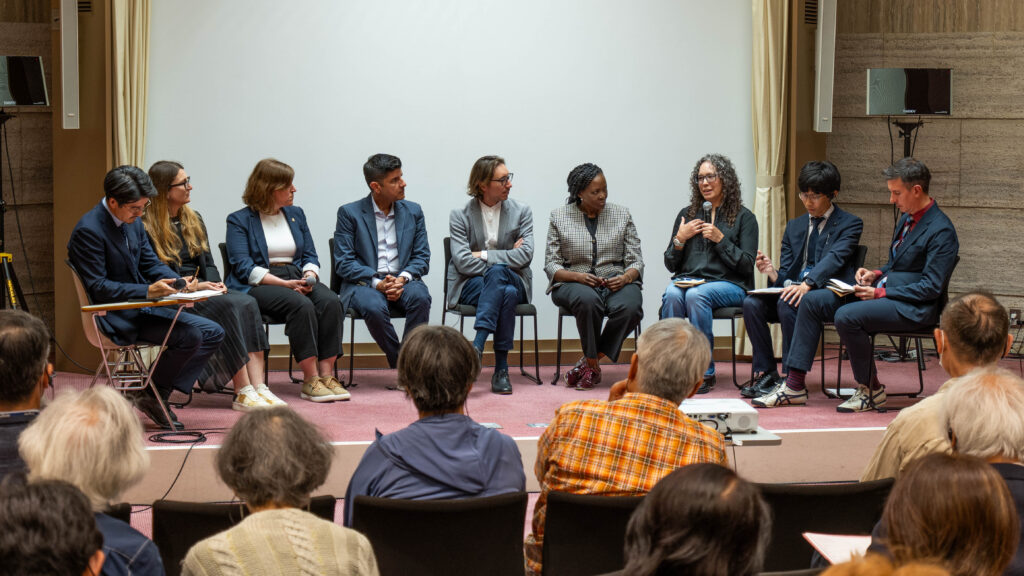
In the panel discussion, panelists – having participated in the pre-symposium site visits and workshops in Kanazawa, shared key takeaways and reflections on what they had learned and experienced. They spoke about the insights and inspirations they hoped to bring back to their own cities and contexts. The panelists praised Kanazawa’s unique water system and community lead fireflies conservation activities. The panelists also shared their challenges their cities are facing such as extreme heat, flooding, harmful pesticides, lake pollution and difficulties in securing funds. The panelists emphasized adopting a nature-based solution as well as increasing green and blue infrastructure would be the key to building a sustainable urban city. The discussion concluded that while each city has different challenges, community participation is critical to addressing biodiversity.
To conclude the symposium, Shinobu Yamaguchi, Director of UNU-IAS, emphasized that urban ecosystem restoration is fundamentally about people’s involvement – nature thrives when people are engaged. Referring to the examples shared by panelists, she remarked that restoring ecosystems also means restoring relationships – between people and place, between past and future, and among the diverse communities who share the same urban space.
The symposium was co-hosted by UNU-IAS OUIK, the Ministry of the Environment, Japan (MOEJ), Kanazawa city. It was supported by United Nations Environment Programme (UNEP), Local Governments for Sustainability (ICLEI) Japan, Ishikawa Prefecture, The Hokkoku Shimbun.
For more information, please watch the following video (recording of the symposium).
※Related article: Cities Share Solutions for Reconnecting with Nature & Culture | United Nations University
Firefly Survey in the Kikugawa Area – Reaffirming the Richness of Nature Remaining in the City
On June 27, 2025, the United Nations University Institute for the Advanced Study of Sustainability (UNU-IAS OUIK) conducted a citizen-participatory firefly survey in the Kikugawa area of Kanazawa City. This activity was part of OUIK’s SUN Project (Sustainable Urban Nature Project) and was co-hosted with the Kikugawa Community Center.
Prior to the survey, Mr. Mitsuhide Shinmura (Chairman of the Kanazawa Firefly Society, Secretary-General of the Ishikawa Firefly Society), gave a lecture. Drawing on his many years of experience in firefly conservation in Kanazawa, he explained in detail about the ecology of fireflies, the conditions of their habitats, and the importance of community-based conservation activities. He mentioned, “Fireflies symbolize the richness of urban nature. Water channels and gardens remaining in the community support the habitats of fireflies.”
Following his talk, Researcher Juan from OUIK explained the significance of “biodiversity” and “biocultural diversity” in urban environments. He introduced how familiar natural settings like water channels and gardens in Kanazawa are deeply connected to cultural practices, emphasizing that protecting and nurturing such urban nature contributes to regional sustainability.
After sunset, participants observed fireflies while walking along the Kuratsuki water canal and around garden ponds, with a map in hand. Fireflies were spotted near water channels and in private gardens, revealing that natural life persists even within the city. Participants recorded the number of fireflies observed at each point on survey sheets and submitted their results.
Notably, this year, fewer fireflies were observed compared to last year, likely due to climate and environmental conditions. Continued monitoring and record-keeping are necessary to track changes in the urban natural environment over time.
Through these activities, we aim to deepen understanding of biodiversity in urban areas and foster community efforts to coexist with nature.
First Session of the Youth Empowerment Program Held: Learning about Global Challenges in Kanazawa
Learning the Global and Local Dimensions of SDGs, Climate Change, and Biodiversity
On June 25, 2025, the first lecture session of the “Leadership Development Program for the Next Generation: Changing the World from Kanazawa, Ishikawa” (Youth Empowerment Program) was held at the Kanazawa Mirai no Machi Creation Center. Fifteen high school students selected from within Ishikawa Prefecture joined the session to explore global challenges such as SDGs, climate change, and biodiversity through both international and local lenses.
In the first half of the lecture, Dr. Akio Takemoto (Head of Programme and Administration, UNU-IAS), delivered a talk titled “Climate Change Policy and SDGs: What Are the Current Global Status and Challenges?” Dr. Takemoto outlined the Paris Agreement and the SDGs frameworks. He also explained how international treaties shape domestic policies, discussed the risks associated with renewable energy, and addressed challenges in Japan’s energy and food self-sufficiency. Throughout his lecture, Dr. Takemoto emphasized the importance of youth participation in building a sustainable future in an aging society.
In the second half, Dr. Juan Pastor-Ivars (Researcher, UNU-IAS OUIK) gave a lecture in English titled “Addressing the Biodiversity-Climate Nexus through Nature-based Solutions — Kanazawa Model.” Starting from the close connection between climate change and biodiversity (the biodiversity-climate nexus), he presented practical examples of nature-positive urban development in Kanazawa. These included initiatives utilizing natural resources such as traditional gardens and shrine forests as green infrastructure, repurposing vacant land, and collaborating with local residents to conserve the environment. The lecture introduced approaches to applying international concepts like Nature-based Solutions, Just Urban Transition, and Climate Justice to local initiatives.
One of the most thought-provoking moments for the participants came with the question: “What does justice mean?” The students came to understand that climate change is not only about the environment—it is also a social issue, connected to population changes, gender equality, poverty, and international politics.
The next lecture is scheduled for July 9, where participants will explore regional issues and resilience using case studies of the Noto Peninsula earthquakes and heavy rain disasters
On-site Excursion Held as Part of the Urban Ecosystem Restoration International Symposium
Event Report – Lecture on the cultural and biodiversity values of Nishi Family Garden
In Kanazawa City, many historical heritage sites, such as buildings, irrigation canals, gardens, and sacred forests, reflect a deep connection between culture, nature, and history. The City of Kanazawa actively conducts research and preservation efforts to pass these heritage treasures to future generations.
As part of these initiatives, Kanazawa City is hosting the “Kanazawa Historical Heritage Exploration Month,” from September 28th to November 30th, and OUIK is supporting this program.
During these months, multiple events are underway to experience the city’s historical heritage, including the event that was held on October 12th at the Nishi Family Garden, which was recently inscribed in the process to be designated as a national scenic spot.
Invited by Kanazawa Cultural Department, OUIK’s Research Fellow Dr. Juan provided a lecture and garden tour for 43 attendees.

The event was attended by the Mayor of Kanazawa City, Takashi Murayama, who opened with an introduction, highlighting the importance of Kanazawa’s garden culture and its growing international recognition. He acknowledged the city’s designation as a UNEP Model City for the Generation Restoration project and expressed gratitude to OUIK for its vital role in promoting Kanazawa’s environmental, economic, and cultural values through the Sustainable Nature Project.
In the presentation, Dr. Juan began by describing the natural features surrounding Kanazawa, including its mountains and abundant water resources. He highlighted the unique qualities of Kanazawa’s gardens, shaped by the Hokuriku region’s climate and a supportive social structure established by the Maeda clan in the 16th century. This system allowed a middle class of artisans to flourish, many of whom sought to recreate a miniature Kenrokuen in their homes, nourished by the local canal network.
Dr. Juan then detailed the network of canals and gardens that still exist in the city today. He addressed the challenges these gardens face due to depopulation and lack of maintenance. In the second part of the presentation, he emphasized how this connectivity between canals and gardens is essential for maintaining ecological functions and supporting biodiversity.
To prove this point, Dr. Juan shared findings (2021.9, 2021.11) from the wildlife survey conducted in thirty city gardens, using Mr. Nishi’s garden as an example.
This survey, which used different methods like in situ observation, sensor cameras, IC recorders, and DNA analysis across various seasons, identified valuable species such as the Ayu fish (Plecoglossus altivelis), Peregrine falcon (Falco peregrinus), Euphaedusa tau snail, and fireflies (Lampyridae).
All these results reinforce the idea of the strong connection between cultural preservation and natural conservation since many of these animals have established their habitat in the gardens because they found an environment protected from rapid urbanization, and today, they represent true natural reservoirs.
Through Dr. Juan’s presentation, participants gained a deeper appreciation for the aesthetic, cultural, and ecological values of the Kanazawa Gardens. The discussion emphasized establishing monitoring systems to track animal life in the coming years to ensure ecological continuity. After the presentation, the attendees freely walked around the garden, enjoying a sunny pre-autumn day.
_____________________________________________________________________________
*About Nishi Family Garden: It was created in 1916, Taisho period, in a residential area of the old city, Nagamachi, and has retained its original appearance since then. The adjacent Onosho water canal irrigates the central garden pond, which is surrounded by impressive and large landscape stones, providing from various places of Japan; they are beautifully displayed together with arched bridges and water basins, balanced with high artificial hills located at the rare part of the garden, planted by native vegetation such as pine trees, azaleas, mapples etc, providing to the viewer a deep sense of space and secluded atmosphere reverberating the features of Kanazawa nature.
___________________________________________________________________________
Check about the event on Kanazawa City Official Youtube Channel
Event Report – Final Presentation Session of the “Leadership Development Program for the Next Generation: Changing the World from Kanazawa, Ishikawa 2024” (Youth Empowerment Program)
The final presentation session for the which was newly launched by OUIK this fiscal year, took place on September 16, 2024. The aim of this program is to cultivate global leaders from the local community to tackle global challenges such as sustainable development and climate change. Thirteen high school students from Kanazawa City participated and presented the results of their six-month study on local environmental issues and climate change.
During the presentation, the 13 participating high school students shared the outcomes of their inquiry projects on local environmental issues, which they worked on during their summer vacation. Each student presented solutions and proposals they developed addressing the impacts of climate change and specific environmental problems in their region, actively responding to questions from the audience.
The themes presented included:
– Utilization of abandoned farmland
– Moving away from a car-dependant society
– Proposals for improving ports and surrounding environments
– Reducing emissions of alternative fluorocarbons
– The relationship between Ishikawa/Kanazawa and water
– Green infrastructure in Kanazawa
– Circular economy
The students’ presentations were based on specific data and often suggested realistic solutions. Notably, proposals that included collaboration with local residents and cooperation with government authorities garnered significant interest from participants.
Next Step: Delegation to the 2024 UN Climate Change Conference (UNFCCC COP 29)
Following the presentation, the participating students underwent individual interviews, and Kanazawa Izumigaoka High School student Nanako Kaji and Kanazawa University High School student Mari Honda were selected. These two will represent the UN University delegation and Kanazawa’s youth at the 29th Conference of the Parties (COP29) to the United Nations Framework Convention on Climate Change, scheduled to be held in Azerbaijan this November. They are expected to actively voice the perspectives of Kanazawa’s youth on an international stage and contribute to global climate change initiatives.
This presentation event served as a highly meaningful opportunity to showcase how local youth engage with global issues and propose solutions from their own perspectives. Participants, inspired by the students’ passion and initiative, hold great expectations for their growth as leaders who will support not only their local communities but also the future of the world.
Updates on the activities of the members selected for COP29 will be communicated through the official website and social media of the United Nations University OUIK, so please stay tuned!
Click on the link below to know more about OUIK’s Youth Empowerment Program:
SUN Project: Participatory Action Research (PAR) Kick off in Kikugawa area
May 14, 2024
OUIK’s Researcher, Dr Juan, has initiated Participatory Action Research (PAR) as part of the Sustainable Urban Nature Project in the Kikugawa district, Kanazawa City. This year, emphasis is placed on citizen participation, environmental conservation, and revitalization of neglected spaces in the region through comprehensive research.
This Participatory Action Research (PAR) activity includes collaborative problem-solving, raising awareness, and empowering citizens to adapt effectively to economic and environmental changes.
The PAR initiative in Kikugawa aims to cultivate a nature-rich community through the following five key actions:
- Promoting green (urban nature) growth
- Monitoring biodiversity
- Maintaining green spaces
- Co-creating community gardens
- Encouraging eco-tourism
To kick off the PAR activities, the first session titled ” Let’s increase the Greenery of Cities by Planting Flowers” was held on May 14. Fifteen predominantly female participants engaged in discussions.
Dr Juan introduced PAR in the Kikugawa district and discussed the benefits and challenges of local greening efforts. Subsequently, participants, under the guidance of a local gardener, engaged in planting activities, sharing insights on land preparation, planting techniques, and maintenance.
Following the planting session, Juan evaluated participants’ awareness of nature’s benefits, challenges in expanding nature-rich communities, and indicators of strengthened community cohesion through discussions and surveys.
The next PAR session is scheduled for June 28. This session will primarily focus on biodiversity monitoring, with citizen scientists conducting firefly surveys along the Kuratsuki water canal and in two designated gardens within Kikugawa.
This project continues to drive positive change in the Kikugawa district, leveraging community participation and sustainable practices to create a more nature-rich and resilient urban landscape.



